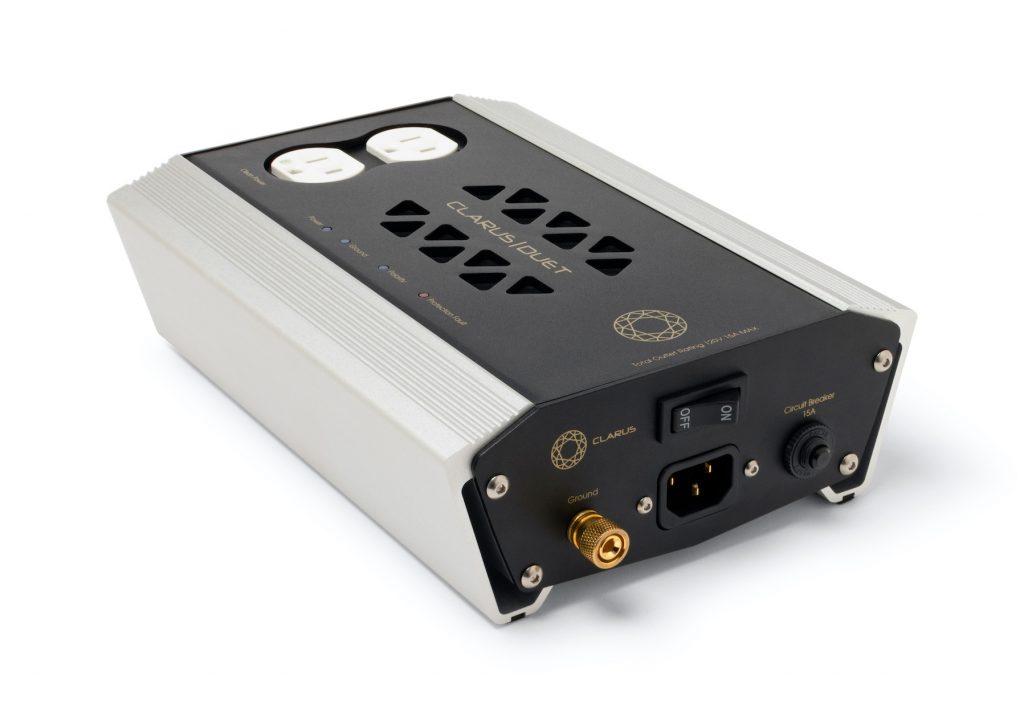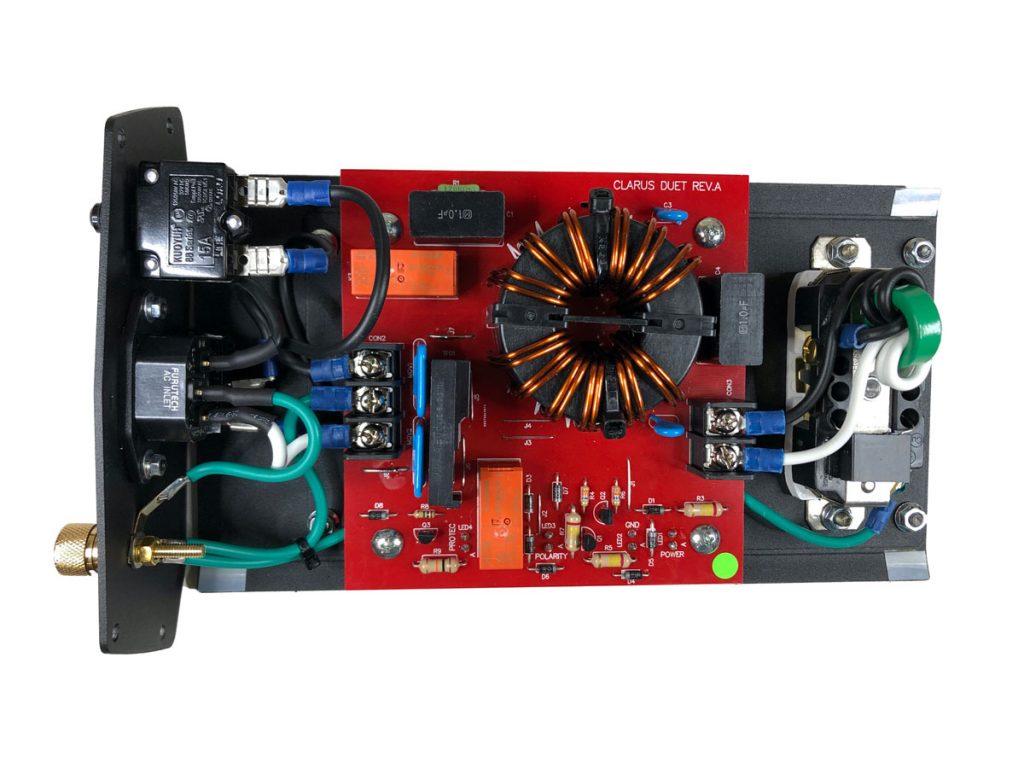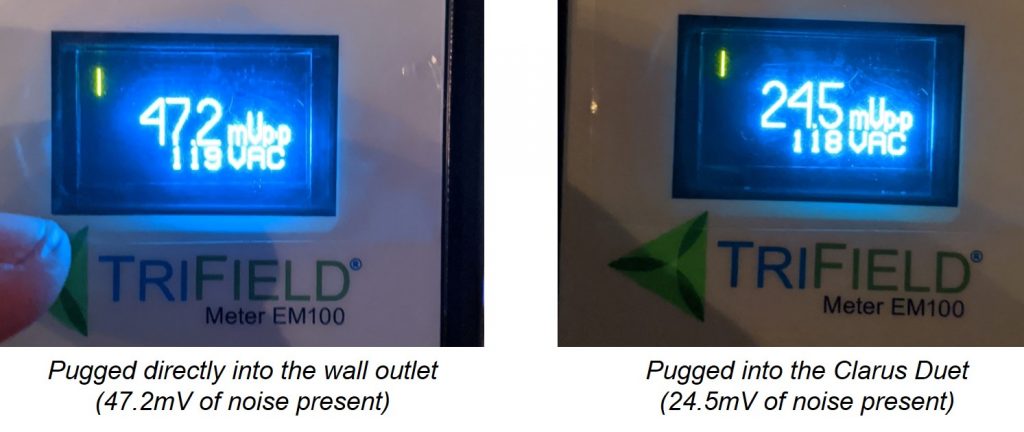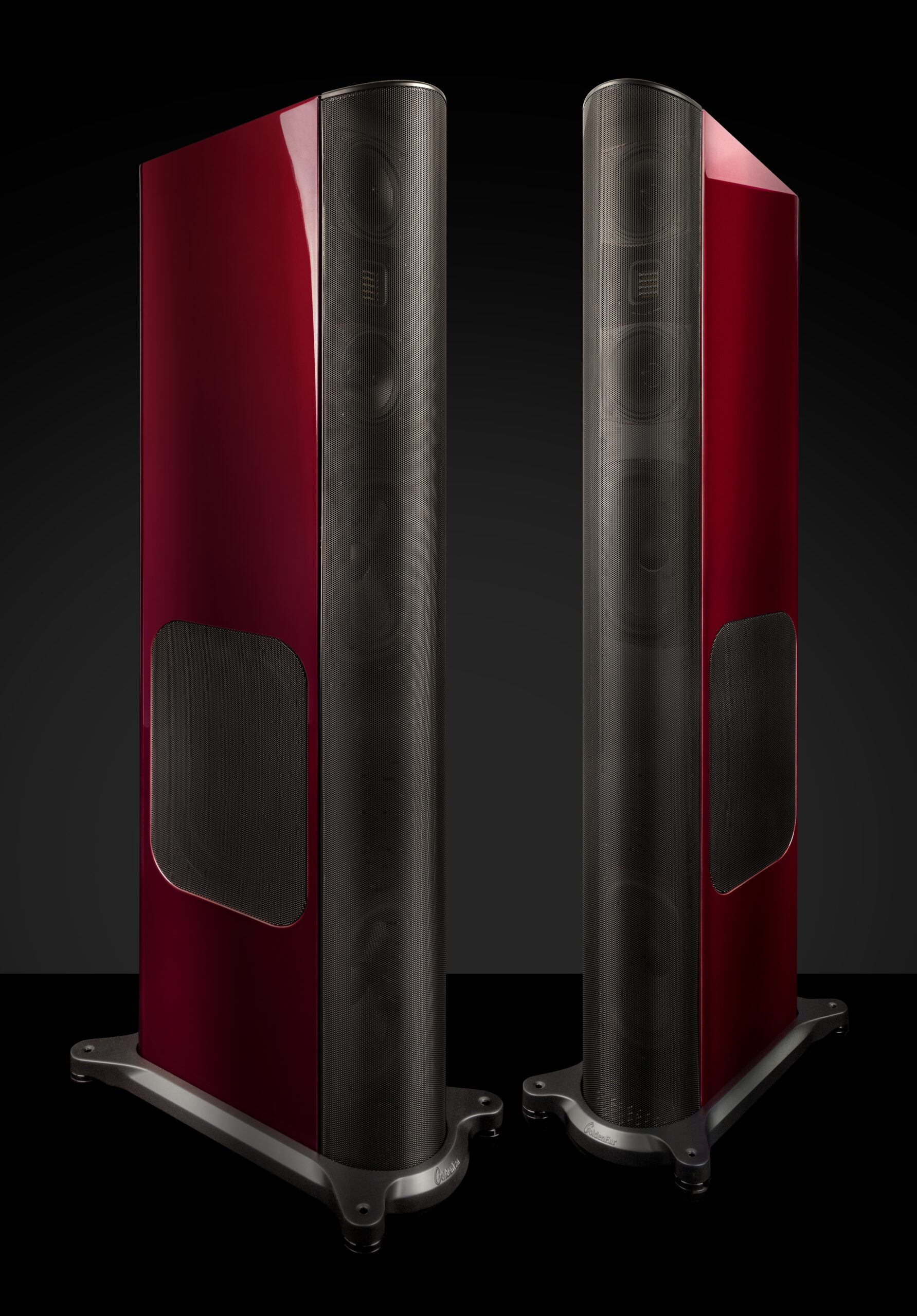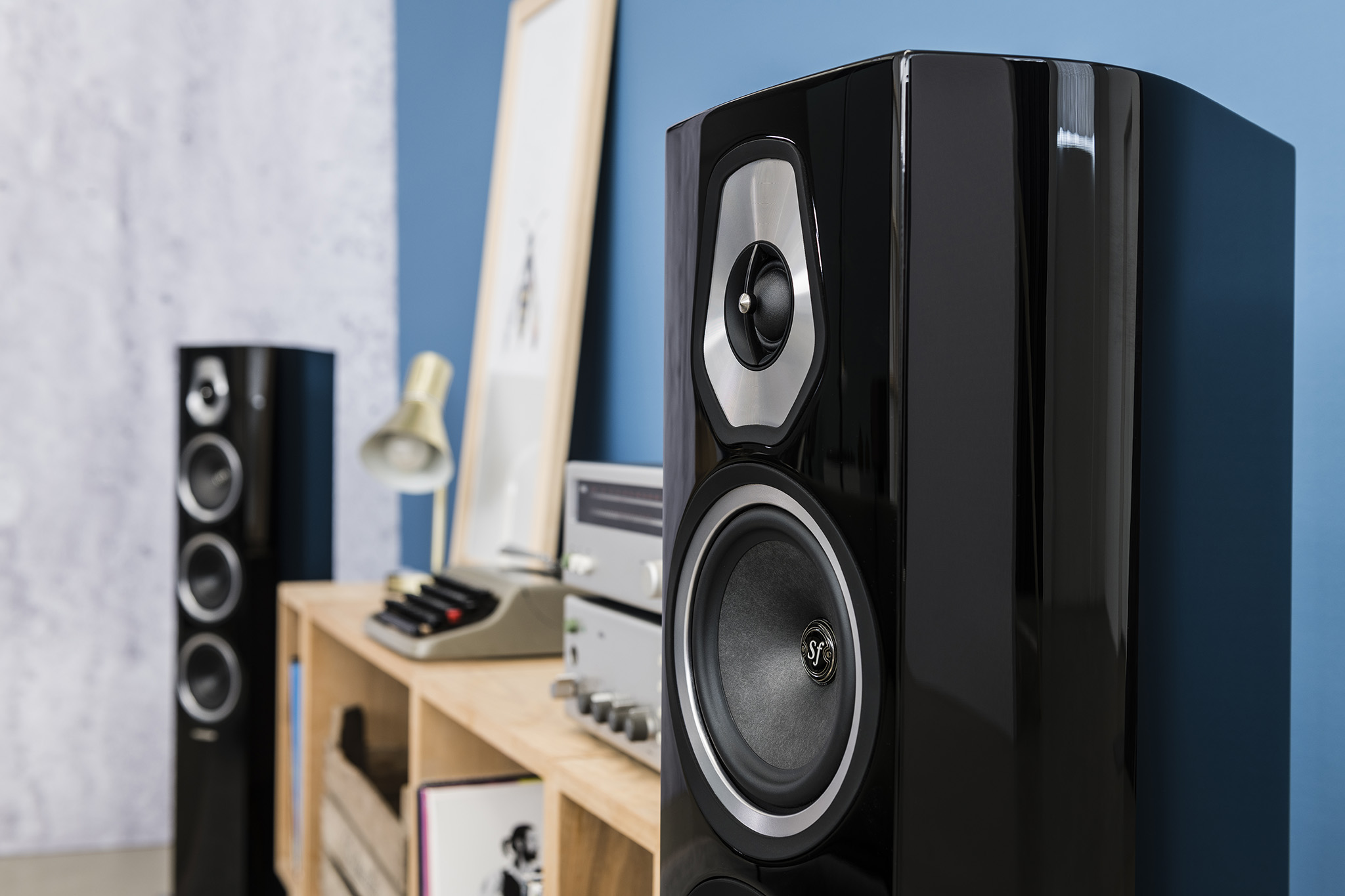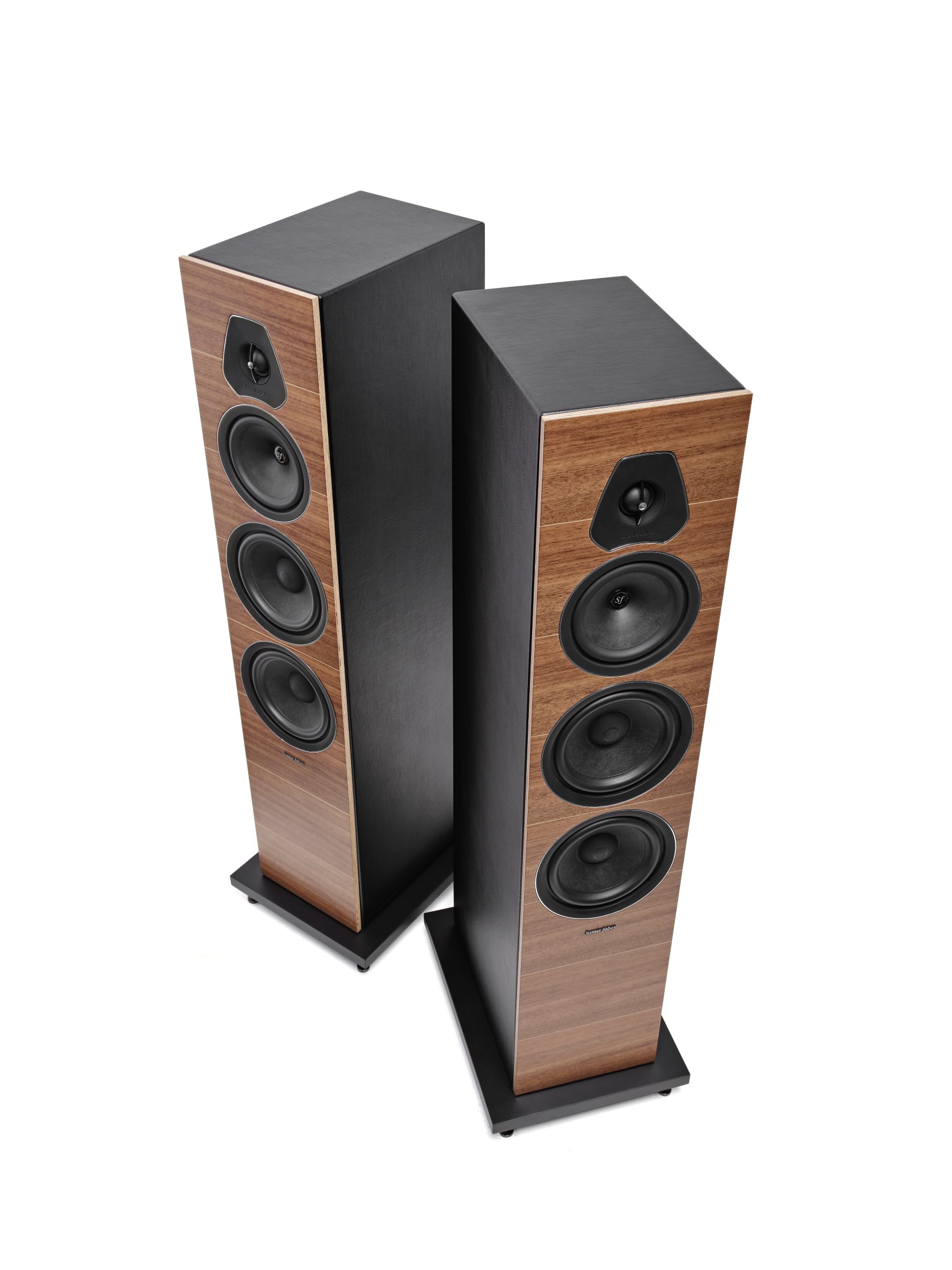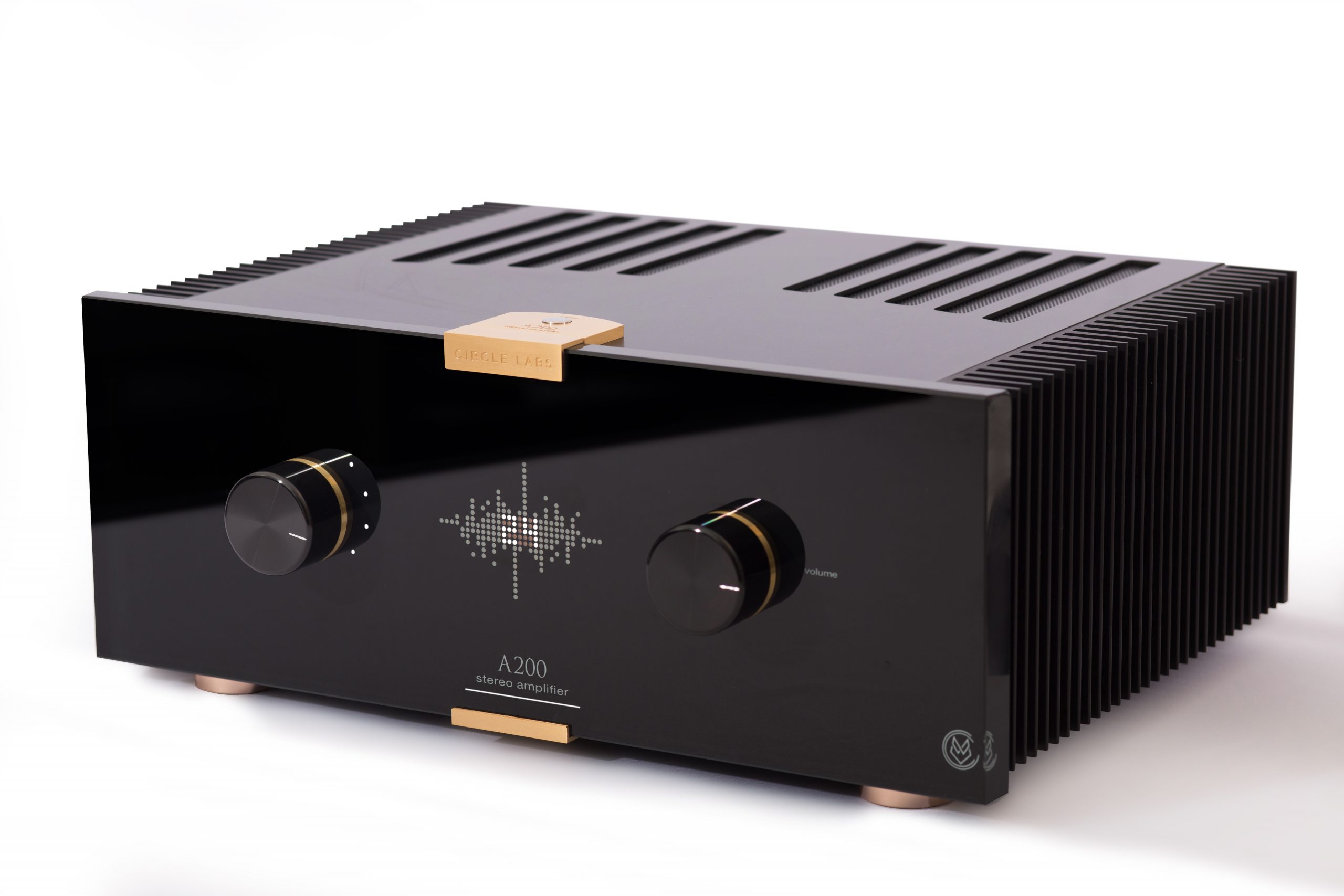"If the power supply of an amplifier is designed correctly, there is no need for a power conditioner."
The quote above is a paraphrase, of a paraphrase, of something that has been said since the first power conditioning devices for audio equipment crawled out of the ocean and began to breathe air. While the quote may be correct in theory, in practice, it is far from the reality of my listening experiences. No less: the canard that line conditioners do not add to the enjoyment of music through a competent audio system needs to be bedded down. The Clarus Audio Duet line conditioner was not only a significant improvement to the system configurations it was run in, but acts as the "cherry on top" in a thoughtful system.
There is a great deal of information that will need to be unpacked to help the people who only "hear" measurements understand why power conditioning improves the sonic quality of an audio system. It will also be equally as important to educate those who blindly believe there is no need to know technical data, to make informed decisions, and avoid pit-falls such as falling for lesser quality conditioning products dressed up in pretty packaging with high prices.
Numbers do matter, even if you cannot directly hear them, yet the sum of the parts is far greater than the individual components contained within, and we need to just listen. It is this author's view that the two schools of thought need not have cleavage between them, rather work harmoniously in service of each other.
Why does this matter, anyway? The Clarus Audio Duet sits in a category of products that are often a point of contention between the aforementioned mindsets. The ensuing struggle can force good products, like the Duet, to get lost in a different sort of noise than what it eradicates so proficiently on an AC power line.
Noise and Context
What is power line conditioning? What is the Duet even filtering? Really. Computer networks need line conditioning, as does sensitive lab equipment, and wouldn't the power supplies of this sensitive equipment be robust enough to eliminate noise that can interfere with their operation?
A power supply, in a very simplistic view, converts the alternating current (AC) from a wall outlet in a home, to the direct current (DC) used by electronics to perform work. Power supplies do this by filtering. Power supply filtering in a low-noise, liner power supply (as found in most high-performance amplifiers) contains a few major components, regardless of how they are dressed.
The power transformer takes the AC (alternating current) voltage in from the wall and makes it more useful for a high current / lower voltage application. Then a rectifier converts the AC from the transformer into DC (direct current). This DC looks more like the series of humps on a camel's back rather than the required, smooth feed of DC voltage. Finally, the capacitor's role, measured in microfarads (uF), is to smooth out those humps (known as ripple) which provides that desirable flat line of DC voltage, while simultaneously supplying a large pool of current for the amplifier to draw from.
The quality of all these electrical components counts. They all induce and possess their own inherent noise, and larger power supplies that are required for high current applications (such as feeding the electronics that power a loudspeaker) can be difficult to make perform with a low level of noise.
Anything that stands in the way of the line supply's ability to deliver instantaneous power to an amplifier, such as a filter choke of poor quality, will reduce the quality of the sonic result. Simply "building in" a high level of specific noise control that does not restrict current (as found in the Duet) is not a cost-effective option. In other words, power supplies have their own job to do, and it is not primarily noise filtering.
Luckily, most power supplies are designed well. Their self-generated noise is controlled through proficient engineering, and transformers inherently circumvent external noise on their own. This is where much of the contention takes place as to the necessity of power conditioners in audio systems.
As we move out of the low frequency spectrums the electronic waves that power supplies operate within and which our ears perceive, we are drowning in a high level of Radio Frequency noise (RF). It all is around us thanks to our modern day, plugged-in world. Radio frequency noise has a very broad spectrum, from tens of kilohertz (kHz or thousands of cycles per second), to thousands of megahertz (MHz or millions of cycles per second). What's worse? This noise does not always act in a predictable manner, or stay put wherever it occurs. Large capacitors also pass this noise with little issue, and it can couple itself through transformers at high enough frequencies.
Much of this RF noise gets into our power grid since wires act as an antenna for it, and then it is delivered to every electrical outlet in our home. This is because at the lower end of RF (up to 10MHz or so), copious amounts of RF noise is created within, then radiated out of the products surrounding us from Fit Bits to furnaces. Since the electrical grid is a parallel system, we are all tied together, as we are when we drive on the main roads through town, and the noise we put on these power lines is akin to the stench of a vehicle with a clogged catalytic converter trying to gun by you on the right.
This is a good time to mention there are better ways of power control / conditioning than the Duet. These include isolation transformers and filters on an industrial scale that are impractical for just about every audiophile, and can cost dozens of times the $1250 that Clarus asks for the Duet. These systems act as a gated community that disconnects and isolates your home power from the problems of being on the main roads.
The primary role of the Duet is to clean up the broad-band, RF noise on the incoming power line, and doing so while providing the required current to the most demanding power supplies found in large amplifiers. This prevents RF line noise from making its way through the power supply, where it is then injected into the fine details of the audio signal being produced.
If there is low-level RF noise contained within the very electricity the amplifier is using to make the audio signal larger, that low level noise will both mask fine detail, and smear transient pulses within a signal. At this point, it matters little that the noise is far outside our hearing range since it is now mated to the DC power used by the amplifier section the supply is feeding. It pollutes akin to impurities in our tap water. The major issue? Unlike tap water, this noise is not filterable after the fact without causing more problems than it solves, so the Duet blocks it at the door before it even comes in.
The secondary role of the Duet is surge suppression and prevention. This also helps eliminate noise in the form of naturally occurring anomalies on the AC power line that our electronics must contend with every day. As demand rises in the electrical grid, components like large capacitor banks are switched into our electrical grid to keep the voltage stable. As this switching occurs, large but extremely short-lived voltage anomalies can occur. Heck, this can occur even when a refrigerator turns on or off. The duet uses a sophisticated system based around Thermal Metal Oxide Varistors (TMOV) that can react within microseconds to take care of these anomalies. The Duet also does so between all the "legs" of your wall plug. This includes: Line to Neutral, Neutral to Ground, and Line to Ground for US domestic 120-volt power.
While the Duet has an integrated circuit breaker for over current situations, the TMOVs will act as a fuse if there is an extreme over voltage situation that has a significant duration or magnitude. Fortunately, these situations are rare, unfortunately this ends the useful life of the Duet. It is, however, far better to lose a $1250 power conditioner than a $15,000 amplifier.
To further get to the sonic result, which is all that matters come the end of the day, it is important to understand how the Duet can filter so well while not creating the bigger problem of restricting current to hungry amplifiers.
The Duet Details
All of the "sales sheet" information about the Duet can be found HERE. The small form factor of nine and three-quarters long, three and one-half inches high, and seven inches wide is nice. The Duet has a hand-full of LEDs, that are not offensively bright, bedazzling the top of the unit that display the state of the state. There is an isolated grounding post, a circuit breaker reset button, an on/off switch, and a 15A IEC connection on one end of the unit.
Clarus does not include a power cord with the duet. In my pleasant conversations with the President of Clarus, Joe Perfito, I found their reasoning to make sense. As you move into more advanced electronics that contain the ability to resolve out extremely fine detail, every system component begins to have a greater impact on the audible result. Choking the Duet with an 18AWG molded power cord of unknown quality is as bad as using a power conditioner that restricts current before the amplifier. For this reason, Clarus included a six-foot long Crimson Red power cord ($860) with the Duet for evaluation. The pairing was lovely1. Joe also mentioned that the Duet was designed to be used with their Aqua high-current power cord that costs $510 in a three-foot length, $860 for a six-foot length, and $1560 for a twelve foot length. This makes the Duet and Aqua MKII soul mates if one was so inclined as to play matchmaker.
The duplex outlet on the top of the Duet is hospital grade. There are many standards for construction and performance listed in the UL 498 document that assure the quality, long-term reliability, and electrical delivery of these outlets. No more is needed in terms of electrical connection. Kudos to Clarus for not bloating the Duet with unnecessary, esoteric components such as a specialized "audio-only" outlet. The discipline to not go overboard shows good engineering rigor and an understanding of what truly matters.
Another good engineering choice was the 30A Clarus Core (C-Core) filter inductor in the Duet. Less because it is capable of double the rated current of the circuit-breaker the duet is designed to handle, and more for its advanced properties. Like the TMOVs being used, Clarus sought out state of the art materials and components to make a product that is a legitimate improvement over other power conditioners on the market, even those that are already doing a good job.
Mechanical movement of the core material used in a filter choke, due to the oscillating magnetic fields around them, cause big problems. In its worst form this vibration can cause current delivery issues, and inject noise into a high-demand piece of electronics. Mechanical movement of the core material is the very hum you hear from electrical transformers. This phenomenon is called magnetostriction. Reducing magnetostriction is a major part of electromagnetic component design. The Duet's filter choke uses a state of the art, highly permeable (this means the material better supports the formation of the required magnetic fields), patented core material that nearly eliminates (it is never zero) the effects of magnetostriction. This also allows for a smaller physical size, contributing to the Duet's slim form-factor.
Now that the typical electro-mechanical and current delivery problems that can occur in power conditioners have been eliminated in the Duet, it is worth noting that it also employs common-mode noise rejection filtering. Common mode noise rejection is why balanced inputs tend to sound better than single ended, and is the best way to eliminate noise that occurs within AC signals.
Measurements
Trying to quantify the full effect of line conditioning with measurements is not an absolute. The methods used to measure the noise can have their own adverse effects on the data, a single measurement cannot form a complete picture of what is happening, or the data can be interpreted multiple ways. Any measurement information needs useful interpretation, which gets easily lost in the minutia of internet armchair expert opinions when a manufacturer, or publication, plop some graphs on a page.
Einstein once wrote a quip by William Bruce Cameron on a blackboard for his students at Princeton: "Not everything that counts can be counted, and not everything that can be counted counts." This is a well-balanced, remarkably scientific approach to anything we are looking to justify with "hard" data, but is intertwined with human perception.
What further complicates the matter of measurements is the Duet has been designed to eliminate RF noise and control transient voltage spikes, the latter can be unpredictable as to when they occur. Lower frequency noise occurring at high levels may render the Duet underwhelming, and these lower frequency anomalies should be inherently handled by the internal power supply of most electronics. This is where the "power supply handles all noise" school of thought comes from.
In consideration of this, the Clarus Duet is far more at home in a system that has worked toward a low noise floor. Low enough to warrant the elimination of the last bit of incoming line noise that occurs in the frequency bands accompanying our everyday, technologically overloaded world that we are trying to escape with our music.
Clarus was reluctant to share their own measurements for the reasons stated above. This is okay. Measurements can become a distraction no good product needs, and they can take away from the work many companies with a great reputation that has been forged in solid engineering are doing, like Clarus.
Fun Fact: All Clarus cables and power conditioning units are designed by Jay Victor. For those of you not familiar with him, he has spent his entire life ironing out the complexities of cables and power in audio systems, and has been doing so for Clarus since their launch 2013.
Clarus Cable and Tributaries Cable fall under the same umbrella of "Gordon J Gow Technologies." This is a tribute to Gordon J Gow, which is the late President of McIntosh, in honor of his commitment to excellence. The delightful story can be found HERE.
All that said: The numbers DO count and ARE meaningful when retrieved and understood in the proper context. So, this itch needed scratching for me, and after several deep conversations with some engineering minds in the industry, the experimentation began to find something useful.
Using an oscilloscope, I bread-boarded a high Q filter to remove the 60Hz signal from the incoming power line so I can see the noise. This was inconclusive since I was unsure of the noise my little circuit was creating on its own, and my oscilloscope did not possess the resolution I was looking for even though the experiment was interesting. Frustratingly, I do not have access to a high-precision, stand-alone spectrum analyzer, or THD analyzer, so I decided on a Trifield/AlphaLab EM100 power line monitor. I take issue with PC based / software driven plug-ins for high precision measuring, so while this seems like it may have been a logical route, it was not one for me.
The EM100 is a simple device that did exactly what was required when trying to define what a usable result would be. It removes the AC signal from a wall outlet, leaving only the noise, then displays the broadband noise as a millivolt (mV or 0.001volt) reading. The EM100 covers the frequency ranges from 10kHz to 10mHz, which is within the range the Duet is filtering (100Khz to 6mHz).
What would be expected is a significant lowering of noise voltages when the EM100 is plugged into the Clarus Duet vs. when it is plugged directly into the wall. Some noise may still exist since the EM100 has a greater bandwidth than the Duet, but most of the noise should be eliminated.
The usefulness of the information is as follows: if the noise is significantly reduced in total via measurement over the Duet's working range, it is doing the job Clarus claims. Since line noise can vary place to place, hour to hour, over frequency range, period, and type, measuring the big picture becomes the only viable option to see if the net result is indeed improved.
If the noise in whole is reduced, the only thing left that would hold back the Duet would be the common detriment of current restriction found in line conditioners. This audible artifact would easily become apparent while listening through the Duet since it is immediately identifiable to those who have heard it over the years. There is a strong consensus within the audio community as to the audibility of current restriction that has held up to the test of time. First, here is the measured result2:
Set Up
It is important when evaluating something like the Duet that good rigor is applied. While the listening section occurs last, it was preformed first, and is the most important evaluation. It is no secret we listen with our eyes first, so it becomes easy to "hear" what we see. Besides, it does not matter if a component contains "unobtanium kenifflin circuit dongles" (yes, I made that up), if it does not add to, or improve the musical experience, it is a lost cause from the go.
The Duet was plugged into a hospital grade outlet with the Crimson Red power cord. The outlet has about eight inches of 12awg wire between it, and the breaker panel. The listening was done using three separate power configurations.
- Amplifier(s) plugged directly into the wall.
- Amplifier(s) plugged directly into the Duet.
- Amplifier(s) plugged into a Furman PM Pro, series II line conditioner.
Three system configurations were employed, all of them used the Bricasti M1 DAC/Network Player as a source.
- The Bricasti M15 amplifier driving a pair of three-way loudspeakers with 8" woofers. The loudspeakers are 94.5dB efficient. Higher efficiency loudspeakers keep the drive signal small at regular listening levels, causing noise to be a greater issue.
- The Bricasti M15 amplifier with a four-way loudspeaker that has dual 10" woofers. While this loudspeaker is still 90dB efficient, the current demand is far greater than the first loudspeakers, and they possess more resolution capability.
- The Bricasti M15 amplifier powering the midbass through tweeter of the 4-way loudspeaker, and a Parasound A21+powering the woofer section in a horizontal bi-amp configuration. The static current demand of this setup is nearly that of a small refrigerator. If the Duet were to cause an audible problem during loading, this would be the configuration to show it.
Common Themes
- It is time to retire my Furman PM Pro. Nearly fifteen years ago when I purchased it, it was one of the very few, affordable power conditioners I heard that improved more than it took away. Aside from extremely expensive full-blown isolation, power conditioning was more of a compromise back then. I have been fortunate, but improvements to my system since then has made those take-aways out-shine the additives. If nothing else, I am appreciative of my experience with the Duet because it has brought the issues with the Furman to light. No need to carry on regarding the Furman any further. It is just not as good for amplifiers as the Duet, or plugging them directly into the wall.
- There were no veils lifted, and the already Vantablack background of the Bricasti M15 was not made quieter. There was no further top-end extension, no added bass definition, and no changes to timbre. In whole: The major difference between the amplifier(s) plugged directly into the wall vs. plugged into the Duet was indeed subtle, but, in places that made a tremendous improvement in my personal engagement with the music.
Listening
Acapella barbershop singing is not for everyone. Its corny, old, and in many ways, it is a period-based musical genre of a short-lived nature. Barbershop, however, is something I sang for many years and have a deep appreciation for. The complex harmonies, especially when all four singers are masterful, can sound magical in nature. They create their own overtones, and dissonances between the voice add a vibratory sonic beating (called Ringing Chords) that is hard to reproduce via audio system. When the music is consonant, the power that is generated is all-out moving.
The quartet Platinum were the Barbershop Quartet champions in 2000. Their rendition of "Cuddle up a Little Closer / Lovely Mine," scored the most points out of any quartet's song in history. All four members are vocal masters, and bass vocalist, Kevin Miles, served as the voice of Disney's Epcot Center.
A personal favorite song of mine comes off their album Auld Lang Syne, which is still available. "Smilin' Through" is a very moving song that captures the essence of lasting love and reflection of its earthy end. It was a song Platinum used in competition, and contains breathtaking harmonies with dramatic dynamic changes.
What makes acapella singing an even more challenging reproduction for a HiFi system is that it causes noise, distortion, frequency response issues, and all the other devils we try and exorcise to be borne naked before us. Multi-part singing harmony is all about harmonics and their generation. The sonic reproduction is not necessarily about capturing the individual singers, but how their voices are interacting, and all the complex modes generated between them.
Soundstage placement was locked in tight with the Duet in the system. Tenor was hard left, then the lead was just left of center, Bass was right of center and Baritone was hard right. This is not new for this recording, except instead of the tenor and baritone appearing to come directly from the left and right loudspeaker respectively, they were even further extended beyond the loudspeakers while being better integrated with the lead and bass. This effect added a tremendous amount of enhanced realism to a musical genre I have heard time and time again in-person, unamplified, and have participated in! Truly subtle, but this enhancement of the soundstage was hair-raising for me.
The complex, harmonic interaction between the four voices was also enhanced by the Duet. This improvement is a little difficult to put into words, but the interactions between the voices and their quality as framed in a sense of realism was more present and stable through the softest softs and loudest louds. Another subtle, but critical difference in consideration of the entire experience.
It was quickly becoming clear that the Duet enhanced the listening experience, and these observations while listening to Platinum were consistent regardless of the system used for evaluation.
Taking a hard-left turn, I queued up the 96kHz/24-bit version of Tool's Fear Inoculum. This progressive metal band uses extremely complex time signatures, with instruments playing different signatures and polyrhythms at the same time. Tool then tops their sophisticated music with haunting, but powerful vocals and lyrics. Their recordings are thoughtful, and the album closer "7empest" received the 2019 Grammy award for Best Metal Performance.
Fear Inoculum was Tool's first album in 13 years. Their individual, and group maturity is unparalleled in its genre. Each song (they all run over ten minutes in length) is a multifaceted musical journey that a quick listen does little justice to. There is no "Chorus / Verse / Chorus" structure to much of their work, and tapping your toes to drummer Danny Cary's polyrhythms is a near impossibility. It would take a great deal of convincing to budge my opinion that Danny Carey is the current king of rock drumming since the passing of legend Neil Peart. Carey may be the greatest of all time to date, or at least tied for first.
The staccato pace of the song "Pnumea" had enhanced space between the starts and stops with the Duet in all system configurations. These spaces occur too fast to "listen" to them, however they fleshed out the dynamic range and complex interactions within the music to a greater degree. Again, the theme continues of enhancing the musical experience, not individual aspects of it.
During the track "Invincible," I noticed an enhanced sense of limitlessness to the music as the song progresses through its softer theme changes and into the dramatic, large conclusion.
Finally, "7empest" followed both above themes and got my blood roiling more than ever with the Duet in place. I did come to find in the third system configuration, when I went to all-out rock levels (my normal listening occurs at, or just below, conversation level), there was not much difference between the amplifiers plugged directly into the wall and the Duet.
I believe this was more due to the anomalies that occur when a room begins to become over-driven, and were unrelated to the Duet. Further, with 100dB and higher peaks from the listening position, my ears began their natural self-protection, and as the eardrum begins to pull tight, it becomes difficult to hear subtlety. The lack of difference otherwise was a great example that the Duet was not limiting current. Enough listening for one day.
The next morning, I scaled up the complexity a bit and blew the dust off Telerc's Star Tracks II. Remember when movies had real music scores? The time when the classical music of science fiction films defined the imaginative universes as much as the captains, aliens, and starships? I remember. This was an interesting time when the lost generation was coming of age, and digital recording had something to prove.
Star Tracks II made its debut in 1990, and contains music from science fiction films of the 1980s. Most are from the Star Trek series of movies. Telarc added in some digital modifications such as bass undertones for more apparent orchestral presence, as well as a digital, "orchestral" piece called "Dimensions." The orchestral music is a great listen, the Cincinnati Pops Orchestra's performance is superb, and the recording quality is what anyone expects when they see the Telarc label on the front of an album's packaging.
The Duet unraveled the orchestral complexity better than I have ever heard it by solidifying the instrument sections within the soundstage, and providing a bit more space around the soloists. As a continuing theme, the already beyond-loudspeaker extension and depth of the soundstage was, dare I say, out of this world.
Songs that have a great deal of dynamic range such as "The Planet Krypton" (John Williams), and "Back to the Future" (Alan Silvestri) did not sound sonically limited, nor did the presentation change during the most intense moments. For me, this was further confirmation that the Duet did not limit the dynamics to an audible degree, even when used with two high-current amplifiers, horizontally bi-amplifying large, high-demand loudspeakers.
Conclusion
A power supply has its own job to do, which is not to filter high frequency line noise on the incoming electrical power to an audio system. Improperly filtering noise on the incoming electrical power can restrict the delivery of current to hungry power amplifiers. Often, the result of restricted current is far more detrimental than benefit of removing noise.
The Clarus Duet has proved both noise reduction and current delivery can be done in a manner that enhances the musical engagement of a system without apparent compromise. The Duet also has a sophisticated protection system that takes care of daily power problems, plus the major ones that can damage expensive amplifiers.
At $1250, the Clarus Duet seems a bit "spendy" for a metal box with a few LEDs, no power cord (which can be another significant expense), and a duplex hospital grade outlet. However, the sonic enhancement and musical joy the Duet adds to a well thought out system belies its understated appearance which reflects its elegant, state-of-the-art design, that delivers unhindered current to power hungry amplifiers.
If you have an audio system and listening space where all the major details are wrapped up, and you are wondering what is next, the Duet should be it. I can feel my posture slump at the thought of removing the Clarus Duet from my system. For me, that is the greatest compliment I could give it.
Clarus Duet
Retail: $1250
Clarus Cable
Gordon J. Gow Technologies, Inc
6448 Pinecastle Blvd Suite 101
Orlando, FL 32809
888.554.2494
1I had a plain, over molded IEC power cord from an amplifier I purchased a couple of decades ago. It contains 12AWG conductors, and is six feet in length. I found while there was an audible difference between it and the Crimson Red MKII through the Duet and into the Bricasti M15 amplifier, it was inconclusive as to which was "better." This difference became more significant when removing the Duet and going directly into the amplifier, moving the preference dial in the direction of the Crimson Red MKII. This is likely reflective of some inherent noise reduction in well-designed cables like the Crimson Red MKII due to tight control of their capacitance, inductance, mutual inductance, and impedance. However, this result makes me unsure that much more is needed from the wall to the Duet than a short, heavy gauge power cord with good contacts.
2 I took measurements several times throughout a 24-hour period and these numbers represent the average of noise seen over that period. The variation was always within a few millivolts when taken via wall or Duet. I observed occasional ticks and crackles through the EM100's integrated speaker when the EM100 was plugged into the wall outlet. These audible anomalies were not present when plugged into the Duet. There is not enough data to really make heads or tails of this, but I thought it was a noteworthy observation, no less.




